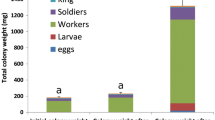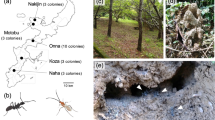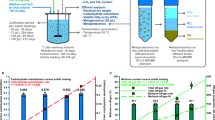Abstract
We analyzed the metaproteome of the bacterial community resident in the hindgut paunch of the wood-feeding ‘higher’ termite (Nasutitermes) and identified 886 proteins, 197 of which have known enzymatic function. Using these enzymes, we reconstructed complete metabolic pathways revealing carbohydrate transport and metabolism, nitrogen fixation and assimilation, energy production, amino-acid synthesis and significant pyruvate ferredoxin/flavodoxin oxidoreductase protein redundancy. Our results suggest that the activity associated with these enzymes may have more of a role in the symbiotic relationship between the hindgut microbial community and its termite host than activities related to cellulose degradation.
Similar content being viewed by others
Log in or create a free account to read this content
Gain free access to this article, as well as selected content from this journal and more on nature.com
or
References
Breznak JA, Brune A . (1994). Role of microorganisms in the digestion of lignocellulose by termites. Annu Rev Entomol 39: 453–487.
Cantarel BL, Coutinho PM, Rancurel C, Bernard T, Lombard V, Henrissat B . (2009). The carbohydrate-active enzymes database (CAZy): an expert resource for glycogenomics. Nucleic Acids Res 37: D233–D238.
Cleveland LR . (1923). Symbiosis between termites and their intestinal protozoa. Proc Natl Acad Sci USA 9: 424–428.
Itakura S, Tanaka H, Enoki A, Chappell DJ, Slaytor M . (2003). Pyruvate and acetate metabolism in termite mitochondria. J Insect Physiol 49: 917–926.
Krogh A, Brown M, Mian IS, Sjölander K, Haussler D . (1994). Hidden Markov models in computational biology: applications to protein modeling. J Mol Biol 235: 1501–1531.
O’Brien RW, Breznak JA . (1984). Enzymes of acetate and glucose metabolism in termites. Insect Biochem 14: 639–643.
Slaytor M, Veivers PC, Lo N . (1997). Aerobic and anaerobic metabolism in the higher termite Nasutitermes walkeri (Hill). Insect Biochem Mol Biol 27: 291–303.
Tokuda G, Lo N, Watanabe H, Arakawa G, Matsumoto T, Noda H . (2004). Major alteration of the expression site of endogenous cellulases in members of an apical termite lineage. Mol Ecol 13: 3219–3228.
Tokuda G, Watanabe H . (2007). Hidden cellulases in termites: revision of an old hypothesis. Biol Lett 3: 336–339.
Vignais PM, Colbeau A . (2004). Molecular biology of microbial hydrogenases. Curr Issues Mol Biol 6: 159–188.
Warnecke F, Luginbuhl P, Ivanova N, Ghassemian M, Richardson TH, Stege JT et al. (2007). Metagenomic and functional analysis of hindgut microbiota of a wood-feeding higher termite. Nature 450: 560–565.
Watanabe H, Nakashima K, Saito H, Slaytor M . (2002). New endo-beta-1,4-glucanases from the parabasalian symbionts, Pseudotrichonympha grassii and Holomastigotoides mirabile of Coptotermes termites. Cell Mol Life Sci 59: 1983–1992.
Acknowledgements
The research described in this paper was funded by the Genomes to Life program sponsored by the US Department of Energy's Office of Biological and Environmental Research and performed in the Environmental Molecular Sciences Laboratory, a national scientific user facility sponsored by the DOE's Office of Biological and Environmental Research and located at Pacific Northwest National Laboratory (PNNL). PNNL is a multiprogram national laboratory operated by Battelle for the DOE under Contract DE-ACO5-76RLO 1830. We also thank Penny Colton for technical editing. The data used in the analysis can requested at http://ober-proteomics.pnl.gov/.
Author information
Authors and Affiliations
Corresponding author
Additional information
Supplementary Information accompanies the paper on The ISME Journal website
Supplementary information
Rights and permissions
About this article
Cite this article
Burnum, K., Callister, S., Nicora, C. et al. Proteome insights into the symbiotic relationship between a captive colony of Nasutitermes corniger and its hindgut microbiome. ISME J 5, 161–164 (2011). https://doi.org/10.1038/ismej.2010.97
Received:
Revised:
Accepted:
Published:
Issue date:
DOI: https://doi.org/10.1038/ismej.2010.97
Keywords
This article is cited by
-
Potential of termite gut microbiota for biomethanation of lignocellulosic wastes: current status and future perspectives
Reviews in Environmental Science and Bio/Technology (2021)
-
Most dominant roles of insect gut bacteria: digestion, detoxification, or essential nutrient provision?
Microbiome (2020)
-
Ecological specificity of the metagenome in a set of lower termite species supports contribution of the microbiome to adaptation of the host
Animal Microbiome (2019)
-
Functional metagenomics reveals abundant polysaccharide-degrading gene clusters and cellobiose utilization pathways within gut microbiota of a wood-feeding higher termite
The ISME Journal (2019)
-
Species-wide Metabolic Interaction Network for Understanding Natural Lignocellulose Digestion in Termite Gut Microbiota
Scientific Reports (2019)



